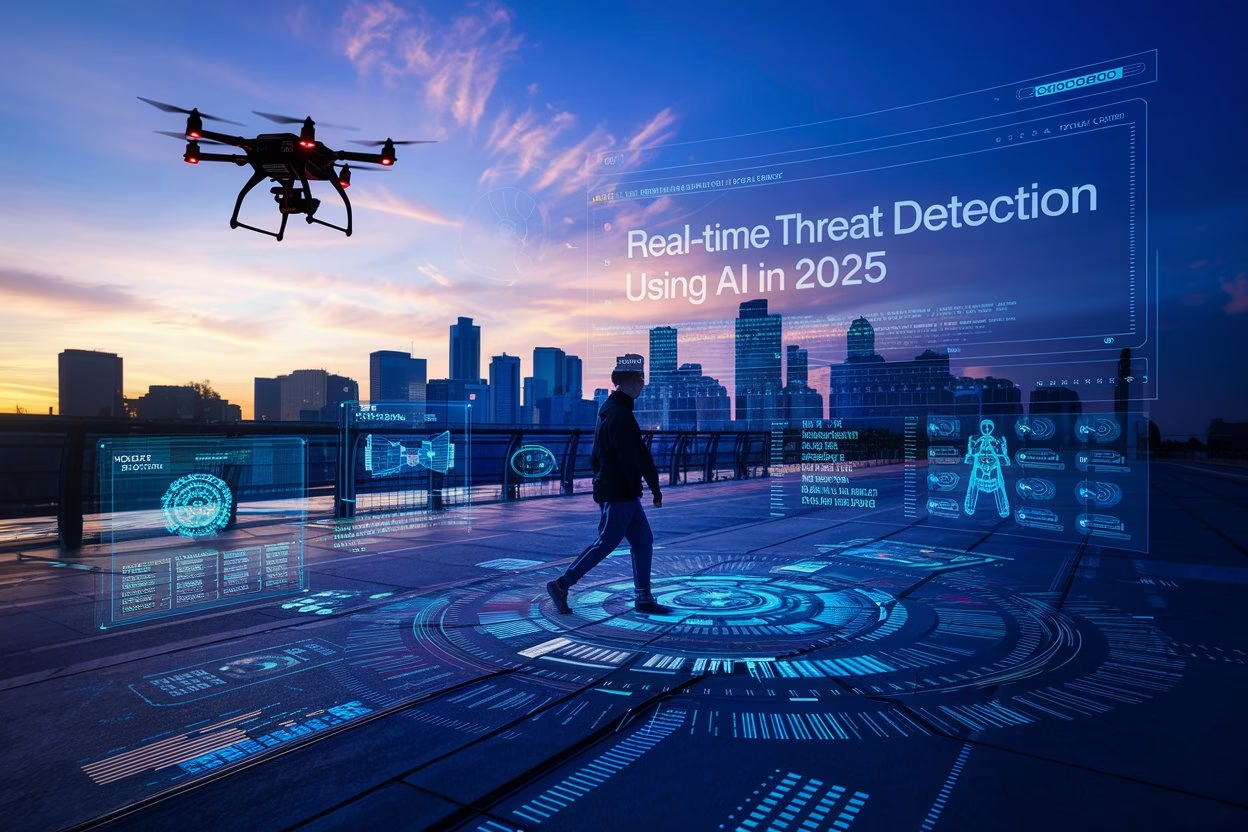The year 2025 marks a transformative era in real-time threat detection using AI, where advanced algorithms and machine learning (ML) systems redefine how organizations combat cyber threats. As digital ecosystems grow increasingly complex and interconnected, the demand for robust, instant, and intelligent threat detection mechanisms has never been greater. Real-Time Threat Detection Using AI in 2025: Revolutionizing Cybersecurity.
This article delves into how AI-driven real-time threat detection operates, its importance in the modern world, key trends, and the future of cybersecurity.

Table of Contents
Why Real-Time Threat Detection is Critical in 2025
Cyberattacks are evolving in sophistication, targeting governments, enterprises, and individuals alike. Traditional cybersecurity measures like firewalls and antivirus software are insufficient against advanced persistent threats (APTs), ransomware, and zero-day vulnerabilities.
Key Challenges Faced by Traditional Systems
- Delayed Responses: Reactive approaches leave organizations vulnerable during the detection-to-response gap.
- Growing Attack Surface: IoT devices, cloud services, and remote work expand vulnerabilities.
- Human Limitations: Manual threat analysis cannot keep up with the volume and complexity of modern threats.
The Role of AI in Real-Time Detection
AI-enabled systems analyze vast amounts of data at lightning speed, detecting anomalies, flagging malicious activities, and initiating countermeasures within seconds.
How AI Enables Real-Time Threat Detection
1. Behavioral Analytics
AI models analyze user behavior to identify anomalies indicative of cyber threats.
- Example: A sudden login attempt from a new geographic location outside working hours raises a red flag.
- Tools: Solutions like Splunk and CrowdStrike employ advanced behavioral analytics.
2. Threat Intelligence Integration
AI integrates global threat intelligence feeds to stay updated on emerging vulnerabilities.
- Example: AI cross-references known malware patterns to detect newly mutated threats.
3. Automated Incident Response
AI systems execute pre-programmed responses to mitigate threats in real time.
- Example: Blocking a suspicious IP address during a DDoS attack without human intervention.
4. Deep Learning for Pattern Recognition
Deep learning models analyze historical data to predict potential threats.
- Use Case: Identifying patterns in phishing emails to prevent future attacks.
5. Edge AI for IoT Security
Edge computing integrates AI models directly into IoT devices for local threat detection.
- Example: Smart home systems using Edge AI to detect unauthorized access attempts.
Top AI-Powered Real-Time Threat Detection Tools in 2025
- Darktrace
- Leverages self-learning AI to identify and mitigate threats autonomously.
- Features: Real-time anomaly detection, automatic threat response.
- Palo Alto Networks Cortex XDR
- Integrates AI and ML to provide extended threat detection and response capabilities.
- Features: Proactive threat hunting and comprehensive visibility.
- Microsoft Sentinel
- A scalable cloud-native security information and event management (SIEM) tool.
- Features: AI-driven insights, incident management, and automation.
- IBM QRadar
- Detects advanced threats using AI-powered analytics and contextual insights.
- Features: Threat prioritization and root cause analysis.
Applications of AI in Real-Time Threat Detection
1. Financial Services
- AI prevents fraud by monitoring transactions for unusual activity.
- Example: Detecting unauthorized credit card usage in milliseconds.
2. Healthcare
- Protects patient data by identifying unauthorized access attempts in electronic health record (EHR) systems.
- Example: AI tools safeguarding hospitals from ransomware attacks.
3. Critical Infrastructure
- Monitors SCADA systems in power plants, water treatment facilities, and transportation networks.
- Example: Preventing cyberattacks on smart grids.
4. E-Commerce
- Safeguards online stores by blocking credential stuffing and carding attacks.
AI Trends in Real-Time Threat Detection (2025)
- Quantum-Resistant AI Algorithms
- Combat emerging quantum computing threats with resilient encryption techniques.
- Adaptive Security Models
- AI systems that continuously evolve to counteract new attack strategies.
- Collaboration with Blockchain
- AI and blockchain ensure data integrity and secure communication during threat detection.
- Human-AI Collaboration
- Augmented intelligence combines AI efficiency with human expertise for complex threat management.
- Zero Trust Architecture (ZTA)
- AI plays a pivotal role in enforcing ZTA by monitoring all access points in real-time.

Benefits of AI-Powered Threat Detection
1. Speed and Precision
AI identifies and neutralizes threats faster than traditional systems, minimizing damage.
2. Scalability
AI systems adapt to the needs of businesses of all sizes, ensuring robust protection.
3. Cost-Effectiveness
By automating threat detection, AI reduces the need for extensive cybersecurity teams.
4. Proactive Security
AI detects vulnerabilities and mitigates risks before they can be exploited.
Challenges in AI-Driven Threat Detection
1. False Positives
AI systems sometimes misinterpret harmless activities as threats, leading to unnecessary interventions.
2. Adversarial Attacks
Hackers use adversarial AI to deceive detection systems.
3. Data Privacy Concerns
The use of extensive data for training AI models raises privacy and compliance issues.
4. High Implementation Costs
Advanced AI systems require significant investment, posing a barrier for small organizations.
The Future of Real-Time Threat Detection with AI
The journey toward secure digital environments will see AI play an increasingly dominant role in real-time threat detection. Future advancements may include:
- Self-Healing Systems: AI repairing vulnerabilities autonomously.
- Collaborative AI Models: Shared AI systems across industries for enhanced threat intelligence.
- AI-Powered Forensics: Simplifying post-attack analysis with AI-driven insights.
Conclusion
In 2025, real-time threat detection using AI redefines cybersecurity by enabling faster, smarter, and more effective responses to cyber threats. From securing financial systems to protecting critical infrastructure, AI ensures a safer digital future. While challenges persist, the benefits far outweigh the risks, making AI a cornerstone of modern security strategies.
By embracing AI-driven real-time threat detection, organizations can safeguard their assets, ensure compliance, and build trust in a rapidly evolving digital world.
Also Read: – How AI Democratizes Technology in 2025: Breaking Barriers to Innovation


